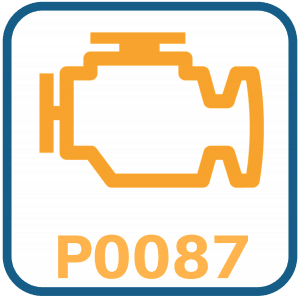P0087 is a relatively common OBD II trouble code. This code indicates that there is an issue with getting enough fuel pressure to the fuel rails. It’s generic, which means that it has the same meaning for the Hyundai Tucson as it would any other vehicle.
This code is most common on vehicles that use a returnless fuel system. This means that the fuel pump adjusts the pressure going to the fuel rail based on the demands of the vehicle, therefore eliminating the need for a return line.
Symptoms: P0087 Hyundai Tucson
If your Tucson is experiencing P0087, it is almost always going to be accompanied by drivability issues. How bad those issues are going to be depends on whether the fuel pressure is staying consistently low, or if it’s fluctuating in and out of normal operating range.
Here are the most common symptoms of P0087 that you may be experiencing in your Tucson.
- Low Power– If the fuel pressure is too low, it will not allow the vehicle to operate above a certain performance threshold. This happens in situations where you need a lot of fuel pressure. The most common ones are running at highway speeds and hard acceleration. It usually feels like it falls flat on its face, or just runs out of go.
- Misfire– Without enough fuel pressure, your Tucson is likely to misfire. If it is misfiring, you’ll likely get P0300 (random misfire, all cylinders) along with the P0087 that brought you here. As long as you fix the lack of fuel pressure, the misfire should take care of itself. The engine will typically run rough or feel choppy when it is misfiring.
- Poor Fuel Mileage– Fuel mileage will suffer with low fuel pressure do to the air/fuel mixture being off. It may not even be very noticeable, it just depends on the fuel pressure.
P0087 Causes + Diagnosis: Hyundai Tucson
Here are the most common causes of OBDII P0087.
Before doing anything, check to see if your Tucson has a fuel pressure test port at the fuel rail or in the fuel line. You’ll need to look up the fuel pressure specs for your engine and model year.
If the fuel pressure is ok, you probably have a bad fuel pressure sensor (or the fuel pump has a bad wiring connection). If there isn’t enough pressure, you could have an issue with the pump, or something is obstructing the fuel’s journey to the rail.
Fuel Pressure Sensor
A bad fuel pressure sensor should not be accompanied by any symptoms other than the check engine light. Typically when the fuel pressure sensor goes bad, it’ll trigger either P0191 or P0190. P0087 is usually the fuel pressure sensor doing its job and telling you that there is something wrong with the fuel pressure.
Fuel Level
Sometimes a fuel gauge can go just bad enough to get a person in trouble. If it is no longer going all the way to the “E” mark, you may just be out of gas. This may sound like nonsense, but I’ve seen it enough to put it on the list.
Give the gas tank a knock. It should register a thud sound with no echo. If it is echoey and hollow sounding, there may be no fuel in there for whatever reason.
Fuel Lines
Get a good flashlight and trace the fuel lines from your Tucson’s fuel rail all the way to the gas tank. If they are going to be crimped (therefore impeding the flow of fuel) it’ll most likely be under the vehicle where it happened. This is often caused by road debris, or even bad jack placement.
Also, make sure to take some good sniffs. If you smell raw fuel at all, that can indicate a leak. The best way to smell for a leak is to start the vehicle cold and shut it down after a minute. That gives the fuel enough time to leak out, without all of the other smells overpowering it.
Tank Damage
This is more of a probably not, but check the fuel tank to make sure that it hasn’t taken a hit that would damage it on the bottom. A good dent is enough to dislodge the sender and pump. This could lead to low fuel pressure at all times, or when the tank is low, but not out. It only takes a second to look.
Bad Fuel Filter
Check to see the maintenance window that Hyundai has set for your particular model year Tucson. If it is past this window in mileage, it would be wise to replace it anyway.
A clogged fuel filter will give all the same symptoms of a bad fuel pump. The only difference is that the fuel pressure between it and the fuel pump will be normal, while the fuel pressure between the filter and fuel rail will be lower than normal operating specs.
Here’s more on diagnosing a bad fuel filter in your Tucson.
Fuel Pump
If the fuel pump has gone bad it will no longer be able to send enough fuel to the fuel rail to properly pressurize it and P0087 will be triggered. In order to test the fuel pump, you’ll need to test the fuel pressure. Before even doing that, you can listen for the hum of a fuel pump before you even turn the key. Here’s more on diagnosing a bad fuel pump.
Here’s a great video from ChrisFix on how to diagnose and replace a fuel pump:
Conclusion: P0087 Tucson
While there are a lot of things that can cause P0087 in your Hyundai Tucson, the diagnostic process is pretty straightforward. If there is anything that you would like to add, please leave a comment below. Good luck!


